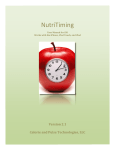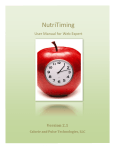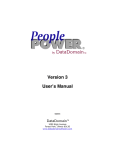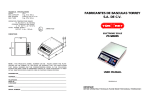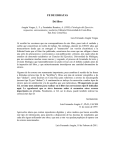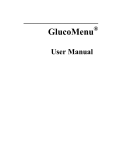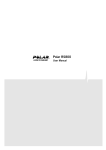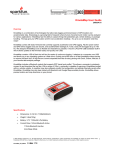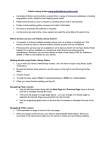Download Get NutriTiming® Advantage Manual
Transcript
NutriTiming User Manual for Web Client Version 2.1 Calorie and Pulse Technologies, LLC Background NutriTimingis the only program that assesses ‘within-‐day energy balance’ (i.e., energy balance in real time rather than at the end of the day or at the end of 24-‐hours.) Staying in good within-‐day energy balance by removing large peaks in energy surpluses and energy deficits has been found to be a critical factor in weight loss, improvement in body composition, helping athletes achieve optimal performance, and better sense of well-‐being. The NutriTimingprogram, which runs on the iPhone/iTouch and/or web, can help users stay in the desirable energy-‐balance range during the day. Basic Operation Users of the iPhone/iTouch can purchase a copy of NutriTiming through the iTunes APP store for a 1-‐time fee of $9.99. All subsequent program updates are provided to iPhone/iTouch users of the program free of charge. • This is a fully functional stand-‐alone program that will provide users with an easy iPhone interface for entering foods and activity to determine within-‐day energy balance and energy substrate (i.e., carbohydrate, protein, and fat) intake, both of which are provided in numerical and graphical form. This information enables the user to adjust eating and exercise habits in a way that sustains a better within-‐day energy balance. • Resting energy expenditure is predicted using a well-‐established and validated equation (Harris-‐Benedict) that incorporates the user’s height, weight, gender, and age to determine caloric expenditure at rest. The user can override this information if they have had resting or basal energy expenditure measured through indirect or direct calorimetry, or a related method. • The energy expended in activity is based on a 1 to 7 relative intensity scale (1=rest; 7=exhaustive activity). Both time of activity and intensity of activity can be selected, and the caloric cost of activity is displayed so that users can optionally adjust intensity to match the energy expenditure derived from a worn device (heart-‐
rate monitor, accelerometer, etc.). • Only activities with intensities above normal daily activities need to be entered, as all other times are predicted. This is a timesaving feature. In addition, activities can be labeled to more easily remember what was done during the day. • NutriTiming™ WEB CLIENT has the same basic functionality as NutriTiming™ on the iPhone/iTouch, and costs st
$7.00 per month ($17 for the 1 month for individuals who have not purchased the iPhone/iTouch APP) or $80.00 per year (plus $10.00 for individuals who have not purchased the iPhone/iTouch App). In addition to the within-‐day energy balance functionality on the iPhone/iTouch, NutriTiming™ on the Web also provides the ability to: automatically assess (no addition user input) vitamin and mineral intake for each assessed day; store an infinite number of analysis days (the iPhone/iTouch APP stores the most recent 7 days of analysis); interact with a nutrition/dietetic expert (expert fee not included) for dietary consultation; and print out energy balance and vitamin-‐mineral analysis results; • NutriTiming™ WEB CLIENT and NutriTiming™ on the iPhone/iTouch are both stand-‐alone programs that can interact with each other. You can run NutriTiming™ WEB CLIENT without the iPhone/iTouch, and you can run NutriTiming™ on the iPhone without the web. Using them together has some added benefits to the user, including a synchronization capability to assure that your most recent entries are on both platforms…If you do a partial analysis on the iPhone/iTouch, you can complete the entries on the web and vice versa. To log onto NutriTiming Web, go to https://nutritiming.com and click on the link for “Client Account Login”. The screen to the left will appear, giving you the option of logging into an existing account (you’ll need the email address and password you created when you set up the nutritiming account), or you can create a new account by pressing the “New Account” button. Payment for a NutriTiming account is handled through a secure PayPal system. When you log into NutriTiming, you will be taken to the “My Overview” screen, which provides the centralized menu options for all the NutriTiming functions. The header menu (“home, contact”) will take you to the NutriTiming™ home page and, if you want to contact NutriTiming, a form for asking a question or making a suggestion. Screen 1: NutriTiming™ Client on the Web Accessing the Program •
NutriTiming User Manual for Web Client, Version 2.1 Page 2 Screen 2: Main Screen “My Overview” The “My Overview” page can be access directly from any of the subpages of NutriTiming™, using the page header menu (“my overview, home, contact”). The following describes the menu options, beginning with those at the top, moving from Left to Right. [Add New Day]: This option lets you initiate a new analysis day, by asking you to update personal information (weight, etc.) and then taking you to the day so you can begin entering food and activity for that day. [Logout]: Pressing this key logs you out of NutriTiming™. This is a good action to take when you have finished working with NutriTiming to assure all files are closed and to make certain no one else using your computer has access to your information. [Edit Account Info]: The main reason to access this operation is to change your logon password. However, if you have a new email address you can also change that with this option. [Edit Personal Info]: This give you access to your personal information, which you can update. Note: When you change personal information such as weight, only the analyses that follow this change are affected by it. Prior analyses use the personal information entered at the time of analysis. [See All Days]: NutriTiming™ displays as many days as possible that fit on your screen. The most recent days are listed at the top of the list. To view all days you have analyzed, including those not visible on the screen, press this button. Select any listed day to edit/modify that day or to view its analysis. [Edit Saved Meals]: NutriTiming™ gives you the option of saving selected lists of foods as a single meal. This is a time saving feature so that when you eat the same meal (for instance, people often eat the same breakfast), you only need to select the meal rather than the individual foods that constituted the meal. Pressing this button let’s you edit (delete, modify title, etc) of these saved ‘meals’. [Edit Custom Foods]: NutriTiming™ gives you the option of adding custom foods to the existing food/nutrient database. This option give you the ability to edit the foods you have added deleting any custom food or by modifying the food description and nutrient contents. [See All Relationships]: This option is unique to NutriTiming™ users. It enables you to optionally create a relationship with a health professional who has the “NutriTiming™ Web Expert” version of the program. This relationship allows the health professional to ‘see’ your entries for the purpose of helping you achieve your dietary, activity, weight, and performance goals. The health professional can’t modify any of the information they can see, but “NutriTiming™ Web Expert” gives them the ability to duplicate any of your assessed days, modify that duplicated day with improved food and activity intake, and show you (both with comparison graphs and nutrient lists) how the proposed changes could affect both your energy balance and nutrient intake. This button lets you view the health professional relationships you have established. Health professionals who are appropriately credentialed and who have “NutriTiming™ Web Expert” are listed on the home page with fees, webpage and email links so you can decide if you want to work with a Health Professional and, if so, which health professional has the credentials and background you seek. Any relationship you initiate with a health professional can be immediately terminated on your command without affecting your entries on NutriTiming™ Web Client. NutriTiming User Manual for Web Client, Version 2.1 Page 3 Screen 3: Initiate New Day Adjust Personal Info Screen 4: Initiate New Day Enter Food and Activity When initiating a new day, you will first be taken to this screen. This screen lets you update/change your personal data for the day. You can change the day of analysis (this can be any past day and any future day), you height (likely for someone in the growing years), weight (possible for anyone), the time you think you’re going to wake up and go to sleep (this can be modified if it is different than you expected it to be), whether you wish to override the predicted Resting Energy Expenditure (REE), and the last time you ate something the day before the analysis day. Pressing [Save and Proceed] saves your entries and takes you to the food and activity entry screen for the day just initiated (See Screen 4). Pressing [Cancel and return to Days List] aborts the “add new day” function and returns you to the previous screen. Of these personal items that you can enter/modify, perhaps only two of them require additional explanation: “Should override REE”: The default for this value is “No”, meaning that the resting energy expenditure (REE) value used by the program is the one that has be estimated using a validated regression equation that incorporates (height, weight, age, and gender). Some users have had REE measured using indirect or direct calorimetry or through some other validated device/technique. For those users who have a measured REE and wish to use that value instead of the one predicted by NutriTiming™, change the “Should override REE:” value to “Yes” and enter the hourly REE value in the “Override REE” field. Make certain the value you enter is the hourly value and not the 24-‐hour value. (Hourly values will be in the neighborhood of 40 to 90; 24-‐hour values will be in the neighborhood of 960 to 2,100.) “Last meal day before”: Enter the time you ate or drank anything with calories the day BEFORE the analysis day. For instance, if you had a snack at 10pm, please enter 10pm. If you had dinner at 6pm and had no source of calories before you went to bed, enter 6pm. This helps NutriTiming™ predict your energy balance going into the analysis day. Note: If the day before the current analysis day was analyzed, NutriTiming™ will use the ending energy balance value as the beginning energy balance value for the current analysis day. In this case, entering the “Last meal day before” is not necessary. This screen displays the hourly energy expenditure values, listed as activity values (intensity factors 1.0 through 7.0); and the hourly energy intake values, listed as food calories. NutriTiming™ also lists the hourly energy balance values. To modify either the food intake or activity factor for any hour, press “Edit Food” or “Edit Activity” for the hour you wish to modify. (Note: in the screen to the left only the first several hours are shown; additional hours can be viewed by scrolling the page down when you are in NutriTiming™ WEB CLIENT. The menu options to the right of the hourly display allow you to: [Edit the Day’s Personal Info]: The personal information for the day is displayed above the button. If you notice that something should be changed, press this button. [Select Another Day]: If you wish to analyze or modify any day that has previously been initiated for analysis, press this button. A list of analyzed days will appear that you can select from. [Show Analysis]: Will display the energy balance and nutrient analysis (in both graphical and numerical format) for the day being displayed. Options on the analysis page will allow you to print the analyses to your printer or to create a “PDF” of your analysis. NutriTiming User Manual for Web Client, Version 2.1 Page 4 Screen 5: Edit Hourly Foods Screen 6: Edit Hourly Activity Intensity Pressing “Edit Food” next to any hour on the day list (See Screen 4) will display this screen. You can modify foods that have already been added for this hour (i.e., delete a food or modify its amount), and you can add a food to the list of foods to analyze for the selected hour. To add a food to the list, press the [Select New Food For Analysis] button. When you do so a blank field will appear under the heading ‘Name’. Click on that field and enter the first 3 letters of the food you wish to find. You will notice that a pull-‐down list will scroll bar appears below the field, listing all the foods that contain the letters you have typed into the field. You can refine the search by adding a space and any other descriptive term for the specific food you are looking for. Example: If looking for ‘1% milk’ you could enter ‘mil 1’ or ‘milk 1’; if looking for ‘raw apple’ you could enter ‘app raw’ or ‘raw app’. NutriTiming™ uses a very sophisticated search system that allows you to enter any string of letters/numbers in any order to quickly find the food in the database. Note that your ‘custom food(s)’ that you have entered will seamlessly appear in the food list if the letters you have entered are part of the description(s) you gave your custom food(s). Also note that NutriTiming™ uses ‘Ajax’ technology, making your program operation (including the food search system) work as if the program is resident on your hard drive. With any decent internet connection, the program operation is very fast. Once you have selected a food from the pull-‐down list, it will appear under the ‘Name’ header. Your next step is to adjust the unit of measure (“Unit”), which appears to the right of the food description. Click on the ‘Unit’ to view all the units available for the food, and click on the most appropriate unit (i.e., cup, ounce, gram, teaspoon, tablespoon, etc.). With the “Unit” selected, now you can adjust the “Multiplier” to adjust the serving size to the amount you actually consumed. For instance, if you selected “Ounce” as the unit of measure and you consumed 4 ounces of orange juice, the “Multiplier” would be 4 (i.e., 4 x 1 ounce = 4 ounces). If the unit of measure you selected = “Cup”, then the multiplier for this same 4 ounces would be 0.5 (i.e., 0.5 x 1 cup = 0.5 cup = 4 ounces). Please review the calories amount for the food you have selected (as adjusted by the “Unit” and “Multiplier”) and if it looks about right, then press “Save”. This saves the food into your analysis list for that hour. However, you can at any time delete the food or modify it’s amount by adjusting the “Unit” and “Multiplier”, and then re-‐saving the new amount. Continue this process until all the foods consumed during that hour have been entered into NutriTiming™. Pressing “Edit Activity” next to any hour of the day list (See Screen 4) will display this screen, which allows you to adjust the activity intensity factor for the hour. You can also “Label” the activity so you have a record of what you did during that hour, just as you have a record of the food you consumed during the hour. To enter activity at the right intensity, review the activity factor scale, which appears at the right side of the screen. Using the descriptions of each activity factor as a guide, enter the activity factor that best describes your intensity. After selecting the activity factor, enter the amount of time you were involved in this activity during the hour by adjusting “Activity duration”. The caloric ‘cost’ of the activity factor and duration is listed below as “Total: xxxx Calories”. Note, some people use activity monitors or heart rate monitors for predicting the energy (i.e., calorie) cost of activity. If you have one of these monitors, you can adjust the activity factor until the total cost of activity equals that of the activity monitor. When your activity adjustment is complete, you can press [Save and Return], to save your activity adjustments; or [Cancel and Return] to return to the default activity entry, and then return to the hourly day view. NutriTiming User Manual for Web Client, Version 2.1 Page 5 Screen 7: Edit Day’s Personal Info Pressing the [Edit the Day’s Personal Info] button from the “My Overview” screen takes you to this screen, which allows you to edit your personal information. The entry here is precisely the same as described in ‘Screen 3’ when you initiate a new analysis day. Note that all values can be changed at any time during the data entry for a day. For instance, if you predicted that you would fall asleep at 10pm, but actually went to bed at 11:30pm, you can change that value while working on the analysis day. When finished entering data, press [Save and Return]. Pressing [Cancel and Return] keeps the values as they were before you began making changes. Screen 8: Select Another Day Pressing [Select Another Day] lists all days that you have already initiated appear under the heading “Tracked Days”. If you have more days initiated than can appear on your screen, press the [See All Days] button. A list of analyzed days will appear that you can select from. Analyzing or viewing any day that has already been initiated is as simple as clicking the mouse pointer on the day. When you do so you will see the ‘Hour View’ for that day (See Screen 4). Any day that appears can be viewed, analyzed, updated/modified, and printed. Screen 9: Show Analysis Pressing [Show Analysis] from the “My Overview” page displays the energy balance and nutrient analysis (in both graphical and numerical format) for the day being displayed. Options on the analysis page will allow you to print the analyses to your printer or to create a “PDF” of your analysis. The top of the screen shows a within-‐day energy balance graph, with green bars depicting the bounds that most people should strive to stay within during the day. Individuals wishing to lose fat weight must be in an energy deficit (energy thermodynamic principles are still at play), but that energy deficit should be between -‐100 and -‐400 calories. Exceeding that energy deficit increases the risk of losing metabolic mass (i.e., muscle mass), making it more difficult to burn calories and compromising weight loss. Individuals wishing to gain muscle mass should have an energy surplus of +100 to +400 calories, plus resistance activity to motivate muscular enlargement. Exceeding that energy surplus increases the risk of gaining fat mass (muscle mass is accrued slowly so the energy surplus must be subtle.) Because this system constantly monitors energy-‐in and energy-‐out, the relative energy deficits or energy surpluses to lose or gain weight remain the same regardless of where you are in the process. Pressing the [Go Back] button at the top of the page takes you back to the Day’s Hour View. Pressing [Graphical Print View] or [Textural Print View] creates printable output (See Screens 10 and 11). NutriTiming User Manual for Web Client, Version 2.1 Page 6 Screen 10: Graphical Print View The Analysis page also includes a graphical display (Pie Chart) of the contribution of Carbohydrate, Protein, and Fat to total Calories. This piechart is included in the graphical print form view (See Screen 10). As with all of the analysis displays, pressing the [Edit This Day] button on the display takes you to the day’s hourly view. An additional feature of these graphical analysis displays is the ability to move the display on the screen, so if you wish to view the nutrient listing and the energy balance display on the same screen, you dan do so: Press the [Fold] key at the upper right of the graphical display you wish to move. This compresses the display. Now click and grab the display where it says “(Drag to Sort)” and move it to the position you wish on the screen. Now press the “Unfold” button (note: the Fold button changes to Unfold, and Unfold to Fold when you press it.) The Analysis page also includes a list of nutrients, the amount of each nutrient consumed (in units appropriate for each nutrient), the recommended intake for that nutrient, adjusted for age and gender (these recommended values are based on the Dietary Reference Intakes-‐DRI for the United States), and the percent of recommended expressed as a number and histogram. The boundary lines on the histogram are as follows: If a nutrient intake is between 75% and 125% of the recommended value, the bar is green; if the nutrient intake is less than 75% of recommended, the bar is yellow; and if the nutrient intake is greater than 125% of recommended, the bar is red-‐
orange. Pressing the [Graphical Print View] button (See Screen 9) creates a printable page that includes the energy balance graph, the energy substrate distribution pie chart, and the nutrient listing with histograms. The page displays, and then you can send the page to your printer, or create a PDF of the page. Creating a PDF of the page may be useful if you want to send your analysis to someone as an email attachment, or if you wish to save an electronic copy of the page. Note: This page will print on non-‐
color printers in greyscale. NutriTiming User Manual for Web Client, Version 2.1 Page 7 Screen 11: Textural Print View Screen 12: Edit Saved Meals Screen 13: Edit Custom Foods Pressing the [Textural Print View] button (See Screen 9) creates a printable page that lists all the energy values, vitamins and minerals. There is a “note” field that lets you comment on any nutrient value, and a larger note field at the bottom of the page to comment on how you feel, the corrections you feel you should make, etc. As with the graphical print view, you can print the page to a printer or [Print to PDF]. If you wish to save your notations, you should [Print to PDF], save the output by making the filename descriptive (i.e., diet on “May 15 with notes”), and then printing the PDF file if you have a hard copy. NutriTiming™ gives you the ability to save food lists as meals. When you are adding foods for analysis, you can save these multiple items as a “meal”. The next time you have the same meal, you only need to press the “meal” you have saved (a single operation) rather than the multiple items that constitute the meal. Pressing the [Edit Saved Meals] button on the “My Overview” page displays a screen with all your saved meals. You can show the foods that constitute each meal, or remove (destroy) the meal from the list. Note: This time-‐saving feature had added flexibility. When you select a meal to include in an analysis, the individual foods that constitute that meal are displayed. You can edit/modify/delete any of the individual foods once they are displayed. For instance, if the saved meal includes 1 cup of orange juice, but you only consumed ½ cup on the hour you are analyzing, you can adjust the serving size and you’re done. With NutriTiming™ you can now ADD foods to a custom database to be used for analysis. NutriTiming™ uses the latest version of the USDA nutrient database (version 21). However, since new foods are always being developed, the program has a facility for adding custom foods to the database. While these foods do not actually become a part of the USDA nutrient database, they are automatically and seamlessly included in the food search when you are selecting foods for analysis. Keeping your foods separate will allow us to periodically update the nutrient database without impacting the foods you have saved. Pressing [Edit Custom Foods] from the “My Overview” page displays all the foods you have entered into your custom food database. Select any food to edit the description or nutrient contents of the food. NutriTiming User Manual for Web Client, Version 2.1 Page 8 Pressing [New Custom Food] (See Screen 13) takes you to this screen. When entering a food for analysis, make certain the grams of the food, the easy unit (serving, cup, 3 ounces, etc) all match the calories for 1 common food serving. If entering other nutrients (protein, carbohydrate, fat, vitamins and minerals), please be careful that you are accurate in entering the food values. Press [Save and Exit] to save your entries and return to the Custom Foods List. Your new food will now appear on the list. An important feature of Screen 15: NutriTiming™ is the (optional) ability See All to share your information with a credentialed health professional. Relationships Pressing the [See All Relationships] at the bottom of the “My Overview” screen will display this screen. You can subscribe to a new expert of revoke expert rights from this screen. Pressing the “Revoke” button makes it impossible for the expert to see future entries into your NutriTiming™ account. In essence, pressing the Revoke button immediately stops the client-‐expert relationship through NutriTiming™. To subscribe to an Expert you must Screen 16: have the expert’s unique code. You Subscribe to can find a listing of all NutriTiming™ Experts on the NutriTiming™ home Expert page, and each expert has their email address, website, city, business phone, area of expertise, and CODE. We recommend looking through this list to find a credentialed health professional who you believe can assist you, and then look through their website. Perhaps you can even give them a call or send them an email to discuss your goals and learn what they can do to help. If you decide that having an expert work with you is what you want and need to achieve your nutritional goals, then enter the expert’s code in the “Expert Code” field, click on the granting statement, and press the [Save and Return] button. The expert will receive electronic notice that you’re interesting in working together. Remember that you can ‘Revoke’ this relationship at any time (See Screen 15.) ©2009 Calorie & Pulse Technologies, LLC. All rights reserved. NutriTiming™ does not provide medical advice, diagnosis or treatment. Screen 14: Data Entry for Custom Food The contents of the NutriTiming™ program and Site, such as text, graphics, images, and other material contained on the NutriTiming™ Site ("Content") are for informational purposes only. The Content is not intended to be a substitute for professional medical advice, diagnosis, or treatment. Always seek the advice of your physician or other qualified health provider with any questions you may have regarding a medical condition. Never disregard professional medical advice or delay in seeking it because of something you have read or observed on the NutriTiming™ Site! If you think you may have a medical emergency, call your doctor or 911 immediately. NutriTiming™ does not recommend or endorse any specific tests, physicians, products, procedures, opinions, or other information that may be mentioned or implied on the Site. Reliance on any information provided by NutriTiming™, NutriTiming™ employees, others providing information on the Site at the invitation of NutriTiming™, or other visitors to the Site or users of the program is solely at your own risk. The Site health-‐ or medical-‐
related materials that appear on the Site and the Content are provided on an "as is" basis. Privacy: The information you load onto and create with NutriTiming™ web-‐based programs is considered private information that is held on secure servers and will not be disclosed to anyone without your expressed permission. NutriTiming™ web-‐based programs have a feature allowing you to share your information with a specific, designated person who can assist you with your NutriTiming™entries for the purpose of improving your food and exercise patterns. While NutriTiming™ provides the facility for such information sharing, NutriTiming™ has no affiliation with and does not specifically support or endorse any recommendations that result from your interactions with this designated person. To share your information with the designated person, you must read this statement on the NutriTiming™program, check the field next to the program indicating you agree and approve of this action, and then enter the specific code of the person you wish to share your information with. “I hereby specifically grant to the stated Health Professional or other Expert the rights to access, view and analyze my stored nutritional data. I recognize that I can revoke this right at any time.” As indicated, you may at any time withdraw permission for that designated person/health professional to view your information without penalty, and NutriTiming™ will immediately cease the sharing of your information with the health professional or other expert when you so indicate by pressing the appropriate selection on the Site. NutriTiming™ is a product of Calorie & Pulse Technologies, LLC NutriTiming User Manual for Web Client, Version 2.1 Page 9 About the NutriTiming™ App Creator
Dan Benardot, PhD, DHC, RD, LD, FACSM 1
2
Dr. Dan Benardot is a tenured Professor in the Division of Nutrition , and is also a Professor of Biology and Professor of 3
Kinesiology and Health at Georgia State University (GSU), where he co-‐directs the Laboratory for Elite Athlete Performance. He received his doctorate in human nutrition and health planning from Cornell University; is a Fellow of the American College of Sports Medicine; and is a Registered and Licensed Dietitian. Dr. Benardot served as Chair of the Department of Nutrition, Director of Research for the Center for Sports Medicine, and Associate Dean for Research for the College of Health and Human Sciences at GSU. He was GSU’s founding Chair of the Intellectual Property Committee, and developed a successful plan for the creation of the new Institute for Public Health at GSU, which has been in operation for over 5 years. His research focus on energy balance and related issues in competitive athletes has been funded by the United States Olympic Committee, the Gatorade Sports Science Institute, the Georgia Research Foundation, the American Cancer Society, and the California Horse nd
Racing Commission. He was editor-‐in-‐chief of “Sports Nutrition: A Guide for the Professional Working with Active People, 2 edition” (American Dietetic Association © 1993, 335 pgs), authored “Nutrition for Serious Athletes” (Human Kinetics © 2000, 336 pgs; also published in Spanish) and “Advanced Sports Nutrition” (Human Kinetics © 2006, 340 pgs), and co-‐authored “The rd
ACSM Fitness Book – 3 Edition” (Human Kinetics Publisher © 2003, 175 pgs). His most recent book “The Coaches’ Guide to Sports Nutrition” (Coaches Choice © 2007, 241 pgs) was co-‐authored with Dr. WR Thompson. Dr. Benardot also co-‐authored the American and Canadian Dietetic Association position paper on “Physical Fitness and Athletic Performance for Adults” (1993), is on the editorial board for ACSM’s Health and Fitness Journal, and is a manuscript reviewer for The Journal of the American Dietetic Association, The International Journal of Sport Nutrition & Exercise Metabolism, Health Education Research Journal, Obesity Research, and Medicine & Science in Sports & Exercise. He was the first American appointed to the Medical Commission of the international governing body for gymnastics (Fédération Internationale de Gymnastique), works with USA Figure Skating and USA Track and Field (marathon), and was a founding member of the Athlete Wellness Committee for USA Gymnastics. In 1993 he received the ADA Sports and Cardiovascular Nutrition (SCAN) achievement award, in 1995 he was initiated into the Alumni Honor Roll for the State University System of New York, in 1996 USA Gymnastics presented him with the Outstanding Educator Award; in 2002 he received a Doctor of Humane Letters, honoris causa, from Marywood University for his work in the area of sports nutrition; and in 2007 received an International Excellence Award from Georgia State University. Dr. Benardot was in charge of the nutritional health and hydration strategy of the gold-‐medal winning United States Gymnastics Team at the 1996 Atlanta Olympic Games, and the medal-‐winning USA marathoners at the 2004 Athens Olympic Games. He also helped to prepare the USA Marathoners for the Beijing Olympic Games and the Berlin World Championships. He currently serves on the Sports Medicine and Sports Sciences Committee for USA Figure Skating and is on the Advisory Board of the National Center for Human Performance in Houston, Texas. As part of an intellectual property endeavor through GSU (inventor on 2 patent submissions), Dr. Benardot serves as Head Scientific Advisor to Calorie & Pulse Technologies, LLC. -‐-‐-‐-‐-‐-‐-‐-‐-‐-‐-‐-‐-‐-‐-‐-‐-‐-‐-‐-‐-‐-‐-‐-‐-‐-‐-‐-‐ 1
College of Health and Human Sciences College of Arts and Sciences 3
College of Education
2
NutriTiming User Manual for Web Client, Version 2.1 Page 10










